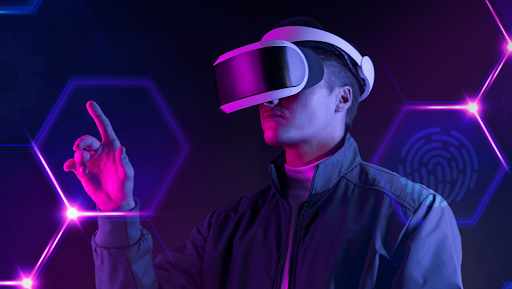Last Updated on May 23, 2024 by Ali Hamza
The physical, digital, and financial worlds are integrating. We have instant access to practically everything we desire, thanks to the technologies we use to run our lives. Cryptocurrency payments, blockchain games, and NFTs are no longer only for crypto techies. Almost all of them are now freely accessible as a part of a burgeoning metaverse.
However, one needs to have a firm understanding of what is the definition of the metaverse and its most recent advances before pursuing these technological components.
What Is Metaverse
A virtual 3D environment containing virtual objects and terrain is known as the metaverse. Imagine a future where you may work from home, browse the newest artwork in virtual museums, or attend a virtual performance with your fellow rock band fans.
In Metaverse, you may engage in various activities, including gaming, shopping, hanging out with friends at a virtual coffee shop, working with coworkers, and more. The digital worlds of cryptocurrency initiatives like The Sandbox and Decentraland are already operational. However, because the metaverse idea is still in its infancy, many of its features are still being developed.
As the idea matures, it’s hoped that it will extend beyond social media and video games. Remote employment, decentralized government, and digital identity are just some features that the metaverse can make possible. The use of linked VR headsets and glasses may also become more three-dimensional, allowing users to move about and explore the three-dimensional worlds physically.
The Latest Evolutions Of The Metaverse
Since Facebook’s name was changed to Meta in October 2021, the phrase “the metaverse” has gained popularity. The social media behemoth invested resources into a new subsidiary, Reality Labs, to spend at least $10 billion in 2021 to support its rebranding. The goal is to create metaverse software, content, and headgear for Augmented and Virtual reality, which CEO Mark Zuckerberg predicts will become as commonplace as smartphones.
The COVID-19 epidemic has also raised awareness of metaverse development. Finally, as more individuals begin working remotely, there is a rising desire for more engaging methods to engage with others.
Tech businesses are integrating cutting-edge technology to fuel the creation of the 3D world to provide a fully immersive metaverse virtual experience.
Technological Trends Driving The Metaverse
Businesses are utilizing cutting-edge technologies to fuel the 3D world and improve the immersiveness of the metaverse experience, including Blockchain, augmented reality (AR), virtual reality (VR), cloud computing, artificial intelligence (AI), and the internet of things (IoT).
Blockchain and Cryptocurrency
For governance, accessibility, interoperability, digital collectibility, and ownership proof, blockchain technology offers a decentralized and transparent alternative. Moreover, users may transfer value using cryptocurrencies while working and interacting with others in the 3D virtual environment.
Cryptocurrency, for instance, may be used to purchase virtual lands in Decentraland. Players can purchase 16×16 meter land parcels as non-fungible tokens utilizing the game’s money, MANA (NFTs). The ownership of these virtual territories may be established and protected with the use of blockchain technology.
Augmented Reality (AR) and Virtual Reality (AR)
Virtual reality and augmented reality are key technologies advancing the metaverse. They may provide customers with a realistic and captivating 3D experience. However, how do these two contrast with one another?
The actual environment is altered by Augmented Reality using digital visuals and characters. It may be used on practically any smartphone or digital device with a camera, making it more accessible than VR.
Virtual Reality has unique workings; it creates a computer-generated virtual environment, similar to the metaverse idea. As a result, large expenditures are being made in developing metaverse-related VR and AR by companies including Meta, Microsoft, and Lenovo.
Artificial Intelligence (AI)
Artificial Intelligence (AI) is an essential tool for the metaverse, affecting every link in the value chain. Furthermore, the metaverse will be immersive and engaging thanks to the support for computing capabilities in semiconductors, processing of user data collected on devices, production of virtual worlds and avatars in software platforms, and content creation and interaction inside experiences.
Massive sets of data can be processed swiftly by AI. In addition, AI algorithms may learn from earlier iterations and use historical data to provide original outputs and insights when used in conjunction with machine learning strategies.
Cloud Computing
Cloud computing solutions will be more and more necessary to process, store, and analyze the data produced on platforms due to the immersive and pervasive nature of the metaverse. It will fail if a metaverse platform struggles to scale or cannot provide a smooth user experience.
The Omniverse Cloud, a set of cloud services introduced by Nvidia in March 2022, enables collaboration and simulation in 3D design for artists, makers, designers, and developers.
The rising metaverse theme will be advantageous for cloud service providers like Amazon, Google, Microsoft, IBM, and Alibaba. They will observe a rise in demand from metaverse systems frantically seeking on-demand computation, storage, and analytics capabilities. In addition, platform owners will want edge computing solutions as the metaverse expands over the next three years.
Internet Of Things (IoT)
The Internet of Things (IoT) connects everything in our physical environment to the Internet through devices and sensors. These gadgets will have a distinctive identity and receive data automatically once they are connected to the Internet. For example, the Internet of Things (IoT) connects medical equipment, voice-activated speakers, thermostats, and many other gadgets to various data.
Data collection and delivery from the physical world is one of the uses of IoT in the metaverse. The computer representations would be more accurate as a result.
A significant number of physical devices may be smoothly connected to the 3D environment by using IoT. In addition, IoT may manage the data it gathers using AI and machine learning, which would further enhance the metaverse environment.
Non-fungible Tokens (NFTs)
Large businesses are increasingly turning to NFTs, including those in the beverage, music, e-commerce, entertainment, sports, and tourist industries. In addition, investors, the media, and consumers are learning about NFTs and the metaverse thanks to these businesses. For instance, Dapper Labs reports that between 2019 and August 2021, sales of NBA NFTs on the NBA’s Top Shots marketplace for buying, selling, and collecting NBA NFTs totaled almost $700 million.
NFT sales increased 570 times from 2020 to 2021, according to NFT data aggregator CryptoSlam, as avatars and digital art became increasingly popular. Many businesses see NFTs as a means into the metaverse and a new income stream, with predictions that the market for new NFTs will hit $30 billion in 2022.
The Bottom Line
The evolution of the metaverse is still in its infancy. Identity verification, privacy control, and more are some challenging areas. Recognizing someone is frequently not difficult in the actual world. However, it will be challenging to identify the person’s identity as individuals move around the virtual world.
Privacy is still another issue. For an immersive experience, the metaverse depends on AR and VR technology. These devices with cameras and personal identification numbers can potentially cause unintended data breaches.
Apart from this if you are interested to know more about Google Classroom API: How it Facilitates Education Provision then visit our Business category.
























